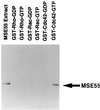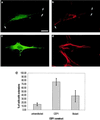MSE55, a Cdc42 effector protein, induces long cellular extensions in fibroblasts
- PMID: 10430899
- PMCID: PMC17736
- DOI: 10.1073/pnas.96.16.9083
MSE55, a Cdc42 effector protein, induces long cellular extensions in fibroblasts
Abstract
Cdc42 is a member of the Rho GTPase family that regulates multiple cellular activities, including actin polymerization, kinase-signaling activation, and cell polarization. MSE55 is a nonkinase CRIB (Cdc42/Rac interactive-binding) domain-containing molecule of unknown function. Using glutathione S-transferase-capture experiments, we show that MSE55 binds to Cdc42 in a GTP-dependent manner. MSE55 binding to Cdc42 required an intact CRIB domain, because a MSE55 CRIB domain mutant no longer interacted with Cdc42. To study the function of MSE55 we transfected either wild-type MSE55 or a MSE55 CRIB mutant into mammalian cells. In Cos-7 cells, wild-type MSE55 localized at membrane ruffles and increased membrane actin polymerization, whereas expression of the MSE55 CRIB mutant showed fewer membrane ruffles. In contrast to these results, MSE55 induced the formation of long, actin-based protrusions in NIH 3T3 cells as detected by immunofluorescence and live-cell video microscopy. MSE55-induced protrusion formation was blocked by expression of dominant-negative N17Cdc42, but not by expression of dominant-negative N17Rac. These findings indicate that MSE55 is a Cdc42 effector protein that mediates actin cytoskeleton reorganization at the plasma membrane.
Figures





References
Publication types
MeSH terms
Substances
Associated data
- Actions
Grants and funding
LinkOut - more resources
Full Text Sources
Other Literature Sources
Molecular Biology Databases
Miscellaneous

